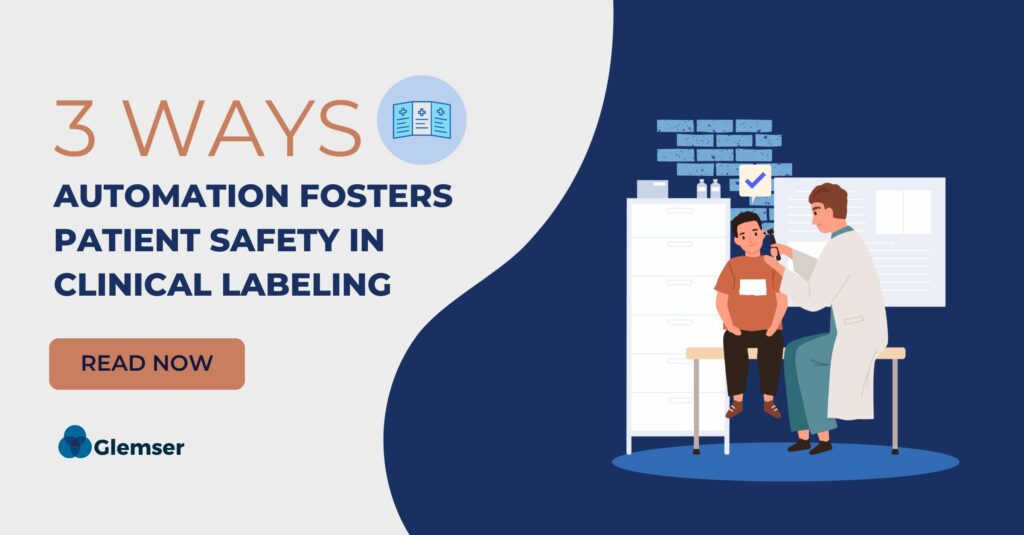
In the fast-evolving landscape of healthcare, ensuring patient safety remains a top priority. Clinical labeling plays a crucial role in this endeavor, as it involves providing patients with clear, accurate information about their medications during clinical trials.
Enter automation—a game-changing technology that’s revolutionizing the way clinical labeling is handled. Here, we explore three key ways automation enhances patient safety in this critical area.
1. Accelerating Drug-to-Market Timelines
One of the most significant benefits of automation in clinical labeling is its ability to streamline the drug development process. Traditionally, creating and updating drug labels for clinical trials involved numerous manual steps, from drafting text to verifying compliance with regulatory standards. These processes were not only time-consuming but also prone to delays, which could postpone the availability of new treatments.
Automation addresses these challenges by programming repetitive tasks such as data entry and first draft generation of labels and regulatory submissions. For example, automated systems can quickly integrate new data from clinical trials into label templates, reducing the time required for manual updates. This efficiency accelerates the approval process, allowing pharmaceutical companies to bring new drugs to market more swiftly.
The impact on patient safety is profound. The domino effect goes like this: the faster you can create a clinical label, the faster clinical trials begin, meaning faster they conclude. The faster the drug gets approved means patients gain access to innovative therapies sooner. This can be crucial for those with life-threatening conditions or rare diseases. In the case of a new cancer drug, for instance, reduced time to market can significantly impact survival rates and improve quality of life for patients awaiting new treatment options.
2. Enhancing Accuracy and Reducing Errors
Accuracy is paramount in clinical labeling, as even minor errors can lead to serious adverse drug events (ADEs). For instance, incorrect dosage instructions or misidentification of active ingredients can result in severe health consequences, including allergic reactions or ineffective treatment.
Automation technologies play a crucial role in minimizing these risks by leveraging advanced algorithms and machine learning to ensure precision. Automated systems can cross-check labeling information against multiple databases, regulatory guidelines, and historical data to identify and correct inconsistencies before labels are printed.
For example, automated quality control systems can compare label data with clinical trial results and safety reports, flagging any discrepancies for review. Additionally, automated data validation can help ensure that all required fields are filled correctly and that no critical information is omitted.
By reducing the potential for human error, automation enhances the reliability of clinical labels. This increased accuracy helps minimize the chances of medication errors, thereby improving patient safety and reducing the risk of ADEs. For patients, this means a higher level of confidence in the medications they are prescribed and their intended effects. Ensuring labels are error-free can also increase the speed of the new drug coming to market.
3. Customizing Information for Better Patient Understanding
Another advantage of automation is its ability to tailor clinical labels to meet diverse patient needs. Not all patients have the same level of health literacy, and medication instructions need to be accessible to everyone, including those with limited English proficiency or varying levels of education.
Automated systems can generate labels in multiple languages and adjust the complexity of the language used based on patient demographics. For instance, an automated system can produce labels with simplified instructions for elderly patients or those with cognitive impairments, while providing detailed explanations for more informed individuals.
Personalized labels can include specific warnings or instructions based on individual patient profiles, such as allergies or pre-existing conditions.
This customization empowers patients by enhancing their ability to comprehend medication instructions. Better understanding leads to improved adherence to prescribed regimens, which is crucial for achieving effective treatment outcomes in trials. For example, patients who clearly understand how to take their medication are more likely to follow dosing schedules accurately, reducing the risk of complications and ensuring better overall health management.
The Broader Impact of Automation
Beyond these immediate benefits, automation in clinical labeling fosters a more efficient and accurate healthcare system overall. By integrating advanced technologies, healthcare providers can improve not just patient safety but also the quality of patient care.
Automated labeling systems reduce administrative burdens and streamline workflows, allowing healthcare professionals to focus more on direct patient care rather than on time-consuming documentation tasks. Moreover, the integration of automation in labeling aligns with broader trends in healthcare innovation, such as electronic health records (EHRs) and telemedicine, which collectively contribute to a more seamless and patient-centered approach to care.
The use of automation opens doors to innovative approaches that prioritize patient well-being and streamline healthcare processes. As technology continues to advance, the potential for further improvements in clinical labeling and patient safety is vast, paving the way for a future where healthcare is not only more efficient but also more responsive to the needs of patients.
Final Thoughts
In conclusion, automation in clinical labeling is transforming the landscape of patient safety in clinical trials. By streamlining drug development timelines, reducing the risk of errors, and customizing labels to meet diverse patient needs, automation not only enhances the accuracy and efficiency of the labeling process but also significantly contributes to better health outcomes.
As technology continues to advance, the role of automation in clinical labeling will only grow, further ensuring that patients receive the safest and most effective treatments possible.
Want to automate your clinical labeling workflow? Contact Glemser today to get started.


